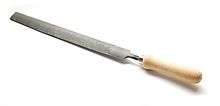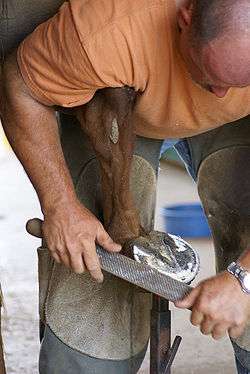Rasp
A rasp is coarse form of file used for coarsely shaping wood or other material. Typically a hand tool, it consists of a generally tapered rectangular, round, or half-round sectioned bar of case hardened steel with distinct, individually cut teeth. A narrow, pointed tang is common at one end, to which a handle may be fitted.[1]


Use
Rasps come in a variety of shapes—rectangular, round, and half-round—and vary in coarseness from finest, "cabinet", to most aggressive, "wood".[2] Farriers, for example, commonly use rasps to remove excess wall from a horse's hoof. They are also used in woodworking for rapidly removing material, and are easier to control than a drawknife. The rough surfaces they leave may be smoothed with finer tools, such as single- or double-cut files. Rasps are used in shaping alabaster. Saws and chisels are used to rough out alabaster work.
References
- Lye, P. F. (1993), Metalwork theory, Book 1, Nelson Thornes, pp. 12–13, ISBN 978-0-17-444313-1.
- Paul N. Hasluck (February 2011). The Handyman's Guide: Essential Woodworking Tools and Techniques. Skyhorse Publishing Inc. p. 119. ISBN 978-1-60239-173-4.